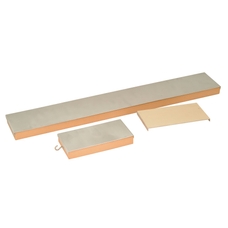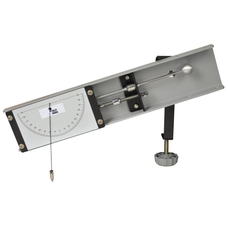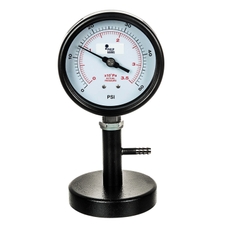Philip Harris Young's Modulus Apparatus
Philip Harris Young's Modulus Apparatus
Product code: E8H25213
Product Description
The Young’s modulus of a material describes how it behaves under a load. It is defined as the ratio of stress to strain. Stress is force per unit area, or pressure, measured in Pa, and strain is a ratio of lengths, so has no units. Therefore, Young’s modulus is a measure of pressure and has SI units of Pa.
Comprises a scale plate carrying a 0 to 30mm scale, and a vernier scale readable to 0.1mm. Both have bars with clamping screws for the wires and hooks for the tension weight and loading masses. A ceiling clamp is provided for the upper ends of the wires, together with a pair of large wood screws for attaching it to a convenient overhead beam, door frame etc.
A tension weight, mass 1.3kg approx., for the comparison wire is also included.
- Supplied WITHOUT load masses or wires.
In addition to the apparatus, the following items are required:
- Set of wires (a mixed set is available to purchase separately)
- Screw Gauge Micrometer (B8R06348)
- Slotted 100g masses (B8A73088)
- Safety Goggles
- AS Level Physics - Mechanics and Materials: The definition of Young Modulus, experiment to determine the Young modulus.
- Safety Goggles should be worn at all times.
- The ceiling bracket comes with two wood screws to secure the bracket to a convenient overhead beam or door frame. This is typically a permanent installation in the laboratory.
- The load on the wires should not exceed 2kg to reduce the risk of the wires breaking suddenly.
- The apparatus is supplied with the Vernier scale already aligned with the 0 pointer.
- The Vernier scale is fixed to the bar and is designed to automatically adjust in response to the contraction and expansion of the wire caused by the applied weights.
- It is normal for the holder to tilt slightly towards the side with the heavier weight due to the wire's expansion and contraction. However, if the tilting seems excessive, please consider the following:
- Ensure the top holder is fixed at an equal level and is stable.
- Verify that the lengths of the wires are equal.
- Check that there are no kinks or bends in the wire.
These steps should help in minimizing any unwanted tilting and ensure accurate measurements.
Further Information
- Age Recommended from
- 11 Years
- Brand
- Philip Harris
- Product Type
- Young's Modulus Apparatus
- Scale Range
- 0 - 30mm
- Vernier Readability
- 0.1mm
The Young’s modulus of a material describes how it behaves under a load. It is defined as the ratio of stress to strain. Stress is force per unit area, or pressure, measured in Pa, and strain is a ratio of lengths, so has no units. Therefore, Young’s modulus is a measure of pressure and has SI units of Pa.
Comprises a scale plate carrying a 0 to 30mm scale, and a vernier scale readable to 0.1mm. Both have bars with clamping screws for the wires and hooks for the tension weight and loading masses. A ceiling clamp is provided for the upper ends of the wires, together with a pair of large wood screws for attaching it to a convenient overhead beam, door frame etc.
A tension weight, mass 1.3kg approx., for the comparison wire is also included.
- Supplied WITHOUT load masses or wires.
In addition to the apparatus, the following items are required:
- Set of wires (a mixed set is available to purchase separately)
- Screw Gauge Micrometer (B8R06348)
- Slotted 100g masses (B8A73088)
- Safety Goggles
- AS Level Physics - Mechanics and Materials: The definition of Young Modulus, experiment to determine the Young modulus.
- Safety Goggles should be worn at all times.
- The ceiling bracket comes with two wood screws to secure the bracket to a convenient overhead beam or door frame. This is typically a permanent installation in the laboratory.
- The load on the wires should not exceed 2kg to reduce the risk of the wires breaking suddenly.
- The apparatus is supplied with the Vernier scale already aligned with the 0 pointer.
- The Vernier scale is fixed to the bar and is designed to automatically adjust in response to the contraction and expansion of the wire caused by the applied weights.
- It is normal for the holder to tilt slightly towards the side with the heavier weight due to the wire's expansion and contraction. However, if the tilting seems excessive, please consider the following:
- Ensure the top holder is fixed at an equal level and is stable.
- Verify that the lengths of the wires are equal.
- Check that there are no kinks or bends in the wire.
These steps should help in minimizing any unwanted tilting and ensure accurate measurements.
Further Information
- Age Recommended from
- 11 Years
- Brand
- Philip Harris
- Product Type
- Young's Modulus Apparatus
- Scale Range
- 0 - 30mm
- Vernier Readability
- 0.1mm

_7Mlbk3h6iE.jpg?width=228&height=228&scale=UpscaleCanvas&anchor=MiddleCenter)

